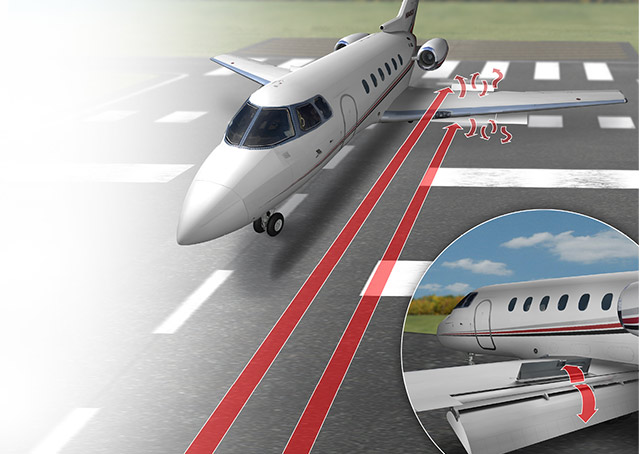
Look at enough ads for business jets and you’ll see that runway performance gets a lot of attention. The emphasis is on getting the most airplane in and out of the shortest runways, providing pilots with more versatility. Need to bring five people and bags to a small community served by a 4,000-foot-long runway? No problem, the brochures will boast. But what if you’re flying a jet with a max landing weight of 20,000 pounds or more?
That’s a big challenge for the jet’s designers, because approach and VREF speeds for airplanes with that kind of mass typically run in the 110- to 130-knot range, depending on the design and the landing weight. Figure that your touchdown aim point may be as much as 1,000 feet from the runway threshold, throw in a displaced threshold, add wet pavement or even a tailwind into the mix, and it’s easy to see why stopping power is so vitally important. You may only have 2,000 feet left to stop, for example—and all the while you’re trying to decelerate from, say, 100 knots. At that speed you’re covering almost 170 feet per second, and it will be more than that if the runway is contaminated!
Reverse thrust certainly can help, if you have it. So can antiskid brakes. But some airplanes, like the Hawker series, and the Premier I and IA jets, use an aerodynamic solution: a lift-dump system. Lift-dump is a speed brake function designed to kill a lot of lift very quickly. It creates plenty of drag and puts more weight on the wheels. The result is improved braking.
In many Hawker jets, once you’ve landed, the drill is to pull the speed brake lever all the way to the Open position, and then aft past a detent into the Dump setting. This action does three things. The upper speed brake panels extend from their normal, in-flight maximum deflection of 30 degrees to a 51-degree deflection. The lower speed brake panels go from 56 to 75 degrees. And the flaps go from the maximum in-flight deflection of 45 degrees to 75 degrees, as well. Add reverse thrust and maximum pressure on the antiskid brakes, and a Hawker pilot has plenty of stopping power.
Premier Is have a similar lift-dump system, but it activates automatically once the airplane’s squat switches detect a weight-on-wheels condition with the power at idle. One or more squat switches don’t work? Sorry, no lift-dump. Premier IAs do away with automatic deployment and give the job to the pilot.
So is lift-dump effective? Yes! So effective that if a Premier IA’s lift-dump system is inoperative, pilots are told to add 53 percent to the airplane’s landing distance. This means lift-dump is virtually essential to safely landing at all but the longest runways.
While lift-dump systems are simple in design and operation, they can create extra workload and confusion in stressful situations, as in the July 31, 2008, crash of a Hawker 800 at the Owatonna, Minnesota, airport. Thunderstorms were five miles from the field, but the first officer was calling the FBO at a time when there should have been a sterile cockpit. The crew was eager to land, so an approach briefing wasn’t conducted, nor were the descent, approach, and missed approach checklists. What’s more, the pilots didn’t notice that the surface wind direction had changed to a slight tailwind.
After touching down, the first officer saw the captain’s hand move the speed brake lever and called out, “We’re dumped.” But they weren’t; the first officer had merely assumed it. After checking, he corrected himself and called out, “We’re not dumped.”
“No, we’re not,” the captain replied, and he initiated a go-around. He closed the speed brakes, applied go-around power, and called for flaps to be retracted to 15 degrees, their go-around deflection. Instead, the flaps were fully retracted. The airplane lifted off momentarily and then crashed, killing all eight aboard. The accident report cited the captain’s late decision—17 seconds after touchdown—to go around, checklist inconsistencies, and fatigue as elements in the accident sequence. We can add to that confusion over the speed brake lever position.
Most recently manufactured business jets—even light jets—incorporate some form of lift dumping. Typically, this happens automatically, when a weight-on-wheels system triggers the extension of ground spoiler panels at the wing roots. Because lift-dump can be so dangerous when close to the ground, manual systems have aural warnings that will sound off when the airplane is in the air and powered up with speed brakes deployed. Even better, most newer airplanes will auto-stow any speed brakes as soon as the thrust levers are advanced beyond a certain value. This feature is helpful when performing, say, an emergency climb, go-around, or missed approach. The crew of the Owatonna Hawker 800 would have appreciated such a system.
As for the extra-flap-deflection portion of a lift-dump system, there are aural alarms and warning lights should you attempt to go into lift-dump by mistake when airborne. That, or the control handle simply won’t move. You certainly don’t want any speed brake or lift-dump action while on short final! That’s why some jets require speed brakes to be stowed below a certain altitude—say, 50 feet agl.
Email [email protected]
Illustration by Kevin Hand



